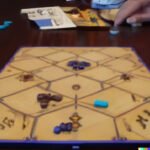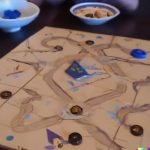Go is an ancient Japanese board game that has been played for centuries, known for its intricate strategies and deep complexity. In this article, we will delve into the world of Go, exploring everything from the basics of the game to mastering advanced strategies. Whether you are a beginner looking to learn the fundamentals or an experienced player seeking to dominate your opponents, this guide will provide valuable insights and tips to elevate your Go skills.
The game of Go is played on a grid with black and white stones, and the objective is to surround more territory than your opponent. It may seem simple at first glance, but as you dive deeper into the strategies and tactics involved, you will discover the depth and sophistication that make Go a timeless and revered game.
From understanding the fundamentals of Go to exploring advanced techniques, this article will cover everything you need to know to become a formidable Go player. By learning from experts in the field and avoiding common mistakes, you can develop both tactical agility and strategic prowess as you navigate through each move on the board. So let’s embark on this journey together, unlocking the secrets and beauty of Go strategy.
The Basics of Go
In order to master the board game of Go, it is essential to have a deep understanding of the basics. From the layout of the board to the significance of each stone, grasping these foundational elements will set you on the path to success in this ancient Japanese game.
The Board and Stones
The standard Go board consists of a grid with 19 horizontal and 19 vertical lines, resulting in a total of 361 intersections. Black and white stones are used to mark territory on the board, with players taking turns placing their stones strategically. Understanding how to utilize these stones effectively is crucial for developing successful strategies in Go.
The Rules of Go
One key rule in Go is that once stones are placed on the board, they cannot be moved, only removed if captured by your opponent. The ultimate goal is to control more territory on the board than your opponent by creating empty spaces enclosed by your stones. It is also important to know that certain moves may be considered illegal based on rules related to repetition or other specific scenarios.
Developing Basic Strategies
As you begin your journey in mastering Go, it’s essential to start with basic strategies that can set the foundation for more advanced gameplay later on. Understanding concepts such as influence, territory, and influence points can help you make well-informed decisions during gameplay. Additionally, learning about opening moves and corner enclosures can provide a strong starting point for beginners looking to improve their skills.
By taking the time to comprehend the basics of Go, including the layout of the board, significance of stones placement and adherence to game rules, players will have a solid foundation upon which they can further develop their strategic skills. As new players become more comfortable with these foundational elements leading into advanced strategies as outlined in subsequent sections will become easier and more intuitive.
Mastering the Board
Mastering the basics of Go is essential for beginners to develop their understanding and strategies in this ancient Japanese board game. As players progress in their skills, they will need to go beyond simply placing stones on the board and start thinking strategically about their moves. In this section, we will explore some essential Go strategies for beginners to help them improve their gameplay and develop a strong foundation in the game.
Understanding Territory and Influence
One of the key concepts in mastering Go is understanding territory and influence. Territory refers to the areas of the board that a player has firmly controlled with their stones, while influence refers to the potential areas a player can control in the future.
Beginners should focus on balancing both aspects, aiming to secure territory while also building influence for future expansion. Understanding how to assess and prioritize these two elements will greatly enhance a player’s strategic thinking in Go.
Utilizing Sente and Gote
Sente and gote are important terms in Go that refer to playing moves with sente allowing you to maintain initiative and play where you want, while gote means you are forced to respond to your opponent’s move. Beginners should aim to play moves with sente as much as possible, gaining an advantage by dictating the flow of the game. Learning how to recognize opportunities for sente moves and using them effectively can give beginners an edge in their gameplay.
Developing a Strong Opening Strategy
In Go, the opening strategy sets the stage for the rest of the game. Beginners should focus on establishing a solid position on the board, building influence while securing territory. By developing a strong opening strategy, players can create a favorable position for themselves as they transition into the mid-game. Understanding various opening patterns, such as fuseki, can help beginners navigate through different scenarios and build a foundation for success in Go.
By mastering these essential strategies for beginners, players can begin to develop their tactical and strategic skills in Go, laying down a solid foundation for further improvement and success in this ancient board game. As they familiarize themselves with these key concepts, they will be better equipped to navigate more advanced strategies and take their gameplay to new heights.
Advanced Go Strategies
Once you have mastered the basics of Go and have become comfortable with the fundamentals of the game, it’s time to take your skills to the next level. Advanced Go strategies are essential for dominating your opponent and achieving success in this ancient Japanese board game. Here are some key strategies to consider as you advance in your Go journey:
- Control the corners: Securing territory in the corners of the board is crucial in Go. By establishing strong positions in the corners, you can build a solid foundation for controlling larger portions of the board.
- Focus on influence: Influence refers to the power that stones exert over surrounding areas of the board. As an advanced player, it’s important to think strategically about how your stones can influence key areas and limit your opponent’s options.
- Develop a balanced strategy: Balancing territorial control with influence is essential for success in Go. While it’s important to secure territory, you must also consider how your stones can exert influence over different parts of the board.
As you delve deeper into advanced Go strategies, it’s crucial to study professional games, learn from experienced players, and continue honing your tactical and strategic skills. By focusing on these key strategies and dedicating yourself to continual improvement, you can increase your chances of dominating your opponent in this captivating and challenging game.
Pro Tips From Go Experts
When it comes to mastering the ancient Japanese board game of Go, learning from the experts is crucial. Whether you are a beginner or an experienced player, insider strategies and techniques can make all the difference in your gameplay. Here are some pro tips straight from Go experts that will help elevate your skills and take your game to the next level:
- Study professional games: One of the best ways to improve your Go strategy is by studying games played by professional players. Watching and analyzing their moves can give you valuable insights into advanced tactics and techniques.
- Focus on balance: Go is a game of balance and territory control. It’s important to maintain a delicate equilibrium between offense and defense, as well as knowing when to play aggressively or defensively based on the flow of the game.
- Practice tesuji: Tesuji refers to clever tactical maneuvers that exploit weaknesses in your opponent’s position. Learning and practicing tesuji techniques will improve your ability to create opportunities for yourself while undermining those of your opponent.
In addition, getting involved in Go communities, whether online or in-person, can provide access to valuable resources such as tutorials, discussions, and even opportunities for matches against advanced players. The exchange of knowledge with fellow enthusiasts can greatly expand your understanding of Go strategy. Lastly, don’t underestimate the value of reading books written by Go masters and visiting reputable websites dedicated to this ancient game.
By immersing yourself in these resources, you’ll gain diverse perspectives on strategy that will enrich your gameplay experience. Mastering these insider strategies and techniques is essential for anyone looking to become a formidable player in the world of Go. With dedication, practice, and a willingness to learn from experts, you can enhance your strategic skills and enjoy a more fulfilling journey through this timeless game.
Common Mistakes and How to Avoid Them in Go
As with any competitive game, Go has its fair share of common mistakes that beginners often make. Understanding these pitfalls and learning how to avoid them is crucial for players looking to improve their skills and achieve success in the game. Here are some of the most prevalent mistakes in Go, along with tips on how to steer clear of them.
One common mistake in Go is playing too defensively. Beginners often focus solely on protecting their own stones and territory, neglecting the importance of seizing opportunities to attack and capture their opponent’s stones. This overly cautious approach can lead to missed chances for gains on the board. To avoid this mistake, it’s essential for players to strike a balance between defense and offense, recognizing when it’s appropriate to take risks and press their advantage.
Another frequent error is failing to consider the whole board during gameplay. Some players become fixated on small-scale battles or local conflicts, losing sight of the broader strategic picture. This narrow focus can result in overlooking opportunities for expansion or missing potential threats from the opponent. To address this mistake, players should practice maintaining awareness of the entire board, positioning their stones strategically across various regions and constantly reassessing the overall state of play.
In addition, a common mistake among beginners is underestimating the importance of life-and-death situations in Go. Failing to accurately assess whether groups of stones are alive or dead can lead to unnecessary losses or inefficient use of moves. To avoid this pitfall, players should dedicate time to studying life-and-death problems and practicing techniques for creating and defending solid positions on the board.
| Common Mistake | How to Avoid |
|---|---|
| Playing too defensively | Strike a balance between defense and offense |
| Failing to consider the whole board | Maintain awareness of the entire board |
| Underestimating life-and-death situations | Dedicate time to studying life-and-death problems |
The Art of Reading the Board
In the game of Go, reading the board is a crucial skill that every player must develop in order to succeed. This involves analyzing the current state of the game, predicting possible future moves, and strategizing accordingly. By honing your ability to read the board effectively, you will be able to make informed decisions that can lead to victory.
One important aspect of reading the board is understanding the concept of influence. Influence refers to the potential control that a player’s stones have over certain areas of the board. By recognizing areas of strong influence as well as weak points, you can plan your moves strategically to capitalize on your strengths and exploit your opponent’s vulnerabilities.
Another key component of reading the board is evaluating territorial or positional advantages. This involves assessing which areas of the board are most valuable in terms of securing territory and controlling key positions. By identifying these strategic hotspots, you can prioritize your moves and allocate your resources more effectively.
Furthermore, developing your tactical and strategic skills in Go also requires foresight and anticipation. This means considering various potential outcomes several moves ahead and envisioning how different sequences of plays may unfold. By mastering this skill, you will be able to adapt to changing circumstances and stay ahead of your opponent’s strategies.
The art of reading the board in Go is an ongoing process that evolves with each game played. It demands sharp analytical thinking, intuition, and awareness of both immediate threats and long-term objectives. With practice and dedication, you can refine your ability to read the board effectively and elevate your overall performance in this ancient Japanese game.
Go Resources
Go, the ancient Japanese board game, is a complex and intricate strategy game that has captured the interest of players around the world. As you start to master the basics and develop your own tactics, it’s essential to have access to resources that can help you improve your skills and deepen your understanding of the game. Fortunately, there are plenty of books, websites, and communities dedicated to the art of Go strategy.
One valuable resource for Go enthusiasts is “The Interactive Way to Go,” an online resource that offers interactive tutorials for beginners and advanced players alike. The website provides lessons on everything from fundamental rules to advanced tactics, making it a great tool for players at any level looking to enhance their skills.
Additionally, online communities such as Reddit’s r/baduk and Lifein19x19.com provide platforms for players to connect with others, share strategies, and seek advice from more experienced players.
For those who prefer learning from traditional print sources, there are numerous books available on Go strategy. “Learn to Play Go” by Janice Kim is a widely acclaimed series tailored for beginners, while “Attack and Defense” by James Davies delves into more advanced techniques. Whether you prefer digital or physical resources, there is no shortage of options available to help you advance your Go strategy skills.
| Go Resource | Description |
|---|---|
| The Interactive Way to Go (Website) | An online resource offering interactive tutorials for players at all levels. |
| r/baduk (Reddit Community) & Lifein19x19.com | Online communities where players can connect, share strategies, and seek advice from experienced players. |
| “Learn to Play Go” by Janice Kim & “Attack and Defense” by James Davies | Acclaimed books that cater to both beginners and more advanced players seeking to enhance their skills in Go strategy. |
Conclusion
In conclusion, mastering the game of Go requires a deep understanding of its complexities and a dedication to honing one’s skills. The ancient Japanese board game may seem simple at first, with its basic rules and straightforward setup, but as players advance, they realize the depth of strategic possibilities that this game offers. The strategies outlined in this article are just the beginning of what players can explore and develop on their journey to becoming a formidable Go player.
As players progress from beginners to advanced levels, they will encounter challenges and triumphs along the way. It’s important to embrace these experiences as part of the beauty of Go strategy. Whether it’s learning from common mistakes, seeking advice from experts, or engaging with the vibrant community of Go enthusiasts, every step taken towards improvement is valuable in itself.
Ultimately, the art of reading the board goes beyond just tactical moves; it involves developing a mindset for strategic thinking and embracing the challenge of outmaneuvering opponents. With perseverance and continuous learning through resources such as books, websites, and communities dedicated to Go, players can unlock their full potential. By immersing themselves in the intricacies of Go strategy, players will find an endless well of depth and beauty in this ancient game.
Frequently Asked Questions
What Is the Strategy of the Board Game Go?
The strategy of the board game Go involves placing stones on a 19×19 grid with the objective of surrounding more territory than your opponent. It requires deep strategic thinking, long-term planning, and the ability to adapt to changing circumstances.
Is Go the Hardest Board Game?
Go is often considered one of the hardest board games due to its simple rules but incredibly complex gameplay. The game’s virtually limitless possibilities make it a challenging mental exercise, requiring immense concentration and a deep understanding of tactics and strategies.
How Do I Get Better at Playing Go?
To get better at playing Go, one should start by learning the basic rules and principles. Practice regularly, study professional games, seek guidance from experienced players, and use online resources such as tutorials, puzzles, and AI opponents to sharpen your skills. Playing against stronger opponents can also help improve your game by learning from their strategies and techniques.

I love playing all kinds of games – from classics like Monopoly to modern favourites like Ticket to Ride.
I created this blog as a way to share my love of board games with others, and provide information on the latest releases and news in the industry.





